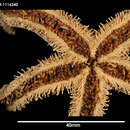en
names in breadcrumbs


"Lysasterias hemiora sp.nov.
(Fig. L, 3; Plate XX, fig. 2)
DIAGNOSIS. In general appearance resembling a narrow-rayed L. perrieri but lacking a series of superomarginal spinelets or of substitute differentiated pustules, the small roundish abactinal pustules appearing to extend right up to the abruptly larger inferomarginal spines and their enclosing sheaths. R 66 mm., r 13 mm., br 13 mm., height of ray at base 12 mm.; ray narrow, very gradually tapered to bluntly pointed extremity, high arched, the inferomarginals, close to the single adambulacrals, defining border of the subplane actinal surface.
DESCRIPTION. The abactinal and lateral pustules are very small and numerous, closer together than the space between. Nearly all of them enclose a small crossed pedicellaria of one size, 35-38 mm. in length. The lowermost series of these small pustules represents the superomarginals. At end of ray the last 1 or 2 pustules have a tiny central spinelet. These are probably resorbed and the material used in the next distal plate to be formed. The proximal 6-12 slender inferomarginal plates carry 1 spinelet, the remainder 2. They measure 2.25-2.75 mm. in length and their sheaths contain a few crossed pedicellariae 0.33-0.45 mm. long, and a lanceolate straight pedicellaria 0.5 mm. long.
The abactinal skeleton of rays is reduced to tiny scattered plates sometimes carrying a tiny spinelet. The antiambulacral bars have 3 or 2 plates proximally and are opposite every fourth or fifth adambulacral. The small inferomarginal elements are slightly separated in the sample examined.
The papulae of disk and proximal half of ray are in numerous groups of 2 or 3; distally they are mostly single. The actinal channel is smooth, soft, and crossed by transverse furrows between inferomarginal plates.
Along furrow margin, from mouth-plates, is a series of pedunculate straight pedicellariae with narrow round-tipped valves; length circa 0.6-0.7 mm.
In the actinal interradial channel can be seen 2 gonopores. In the interbrachial channel are a few small pedunculate straight pedicellariae.
TYPE LOCALITY. St. 189. Port Lockroy, Weincke Island, Palmer Archipelago, 70 m. 1 specimen.
REMARKS. This species, if species it is, belongs to the section of the genus with much reduced marginal plates, wherein the marginal or antiambulacral skeleton consists of a series of spaced transverse bars along the side of ray. In this species there are two or three pieces to each bar, the third, when present, representing an abactinal element. In young examples one would expect to find 5, 6 or even more plates, perhaps connecting up with an incomplete or sketchily outlined abactinal reticulum.
L. hemiora differs from other species belonging in this group, namely chirophora, lactea, belgicae, joffrei in lacking differentiated superomarginal pustules, or spines, and in having crossed pedicellariae of one general size. If chirophora has varieties lacking the broad unguiculate straight pedicellariae, the crossed should nevertheless appear in two sizes, namely, 0.6-0.9 mm. for the larger and 0.3-0.37 mm. for the smaller. In L. belgicae the two sizes are 0.9–1.17 and 0.4 mm. In lactea the inferomarginal and later: crossed pedicellariae measure 0.65-0.73 mm., the dorsal slightly less; while the representatives of the small sort, described as numerous, are only 0.2-0.22 mm. long. The only known specimen of lactea has well-differentiated superomarginal spines.
When all this is said, the remote possibility remains that hemiora may represent freakish sort of mutation of the variable perrieri."
(Fisher, 1940: 245-246)